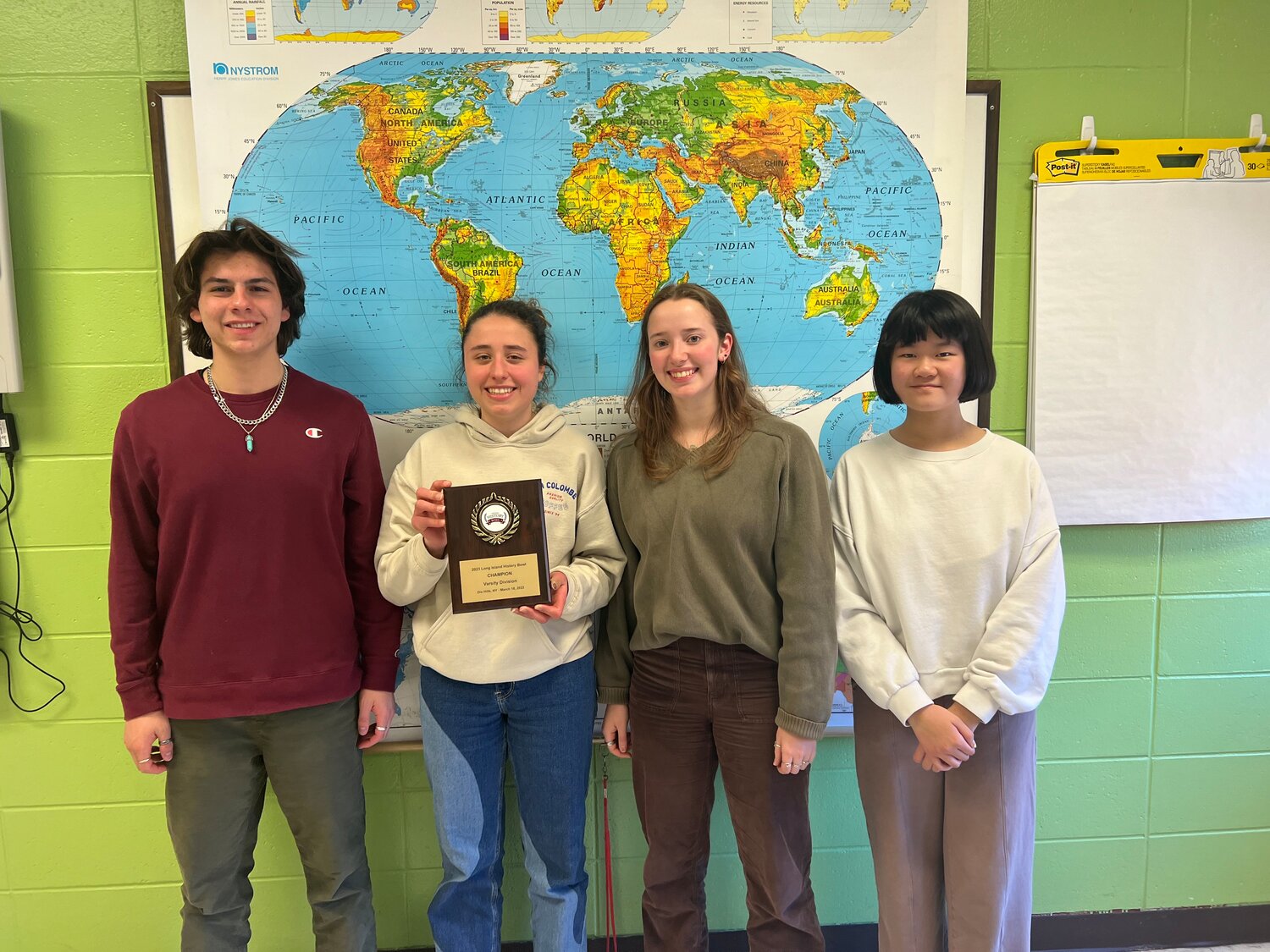Locust Valley High School History Club set to compete in Washington
The four members of the Locust Valley High School History Club are eager to travel to Washington, D.C., to experience what may be the challenge of their lives when they take part in the National History Bee & Bowl April 27 and 28. Seniors Clare Simon and Sophia Delgiudice, sophomore John Hartnett and freshman Abigail Vuong will use their knowledge to answer a variety of history questions in competition with 52 other teams.
The bee is organized by International Academic Competitions. The LVHS History Club qualified for the national tournament by winning the Long Island History Bowl Tournament at Half Hollow Hills High School West on March 18. Locust Valley’s team hit the buzzer with lightning speed, calling out answers to challenging questions during six consecutive head-to-head matchup wins in the four-team round robin. The subjects ranged from arts, sciences, religion, philosophy, language and geography to sports and entertainment.
John Canavan, a LVHS psychology and history teacher, is the club adviser. Although the team often advances to the playoffs in the Long Island Bowl, Canavan said, qualifying for the national tournament is quite an accomplishment.
“This is the first time our team has qualified for the national competition,” he said. “(Competitors) are coming from as far away as Hawaii. The competition is pretty intense.”
Canavan started the club, which meets bimonthly, a decade ago. Its activity paused in 2020 and 2021 due to the coronavirus pandemic.
Each match in a history bee comprises four rounds, with 10 questions per round. Round Two has 10 questions and a bonus, and much like the television’s “Jeopardy!,” Round Three is a lightning round.
“We were neck-and-neck with Kellenberg in the Long Island tournament,” Delgiudice recounted, “and we pulled ahead during the lightning round, getting all the answers correct.”
Simon, LVHS’s salutatorian, who is headed to Cornell University in the fall to study physics, said she became passionate about history after taking the AP U.S. History class. The members of the team have different areas of expertise. For Simon, it’s art history.
“I read books, and I’m into art,” she said. “Knowing the historical context of art gives it different depth. In AP U.S. History I learned there are different points of view on different historical events.”
Delgiudice plans to study psychology at New York University on a pre-med track. She said she always looked forward to history class, even in middle school. Although she has taken several science classes, history gives her balance, she said.
“Everything is a story — it all has a cause and effect,” Delgiudice said. “I like how you can see that everything is interconnected.”
Hartnett, who said he may study law or become a college professor, is fascinated by how history shapes current events. His father is an English teacher, and his mother a Spanish teacher. His historical focus is on literature.
For Simon, being knowledgeable about history requires a general curiosity about the world around you. She often finds herself wondering why things are the way they are.
Being a member of the club has given Hartnett a new outlook on history. “In a group setting, you aren’t learning about history as a bunch of facts,” he said. “The best part is talking to someone and seeing their perspective. When we’re practicing, we have a conversation, discuss what we find interesting. That’s the best part.”
The preparation for the national bowl isn’t any different than it was for the county competition. Luck is a factor, Hartnett acknowledged, and each member has specific areas of expertise. Canavan said the team is balanced, which will help it to do well.
“In other years, one student was the strength,” he said. “There are more contributions coming from the entire team this year. Even Abigail, who’s a freshman, wasn’t frazzled by where she was at the Long Island competition. She was answering the questions.”
The team doesn’t study for competitive events. Members use knowledge from their classes and what they have looked into on their own.
“It speaks to our individual interests in history — how you want to know more,” Delgiudice said.
The questions are hard, the teens agreed. But the buzzer isn’t intimidating. It’s more exciting, Delgiudice said with a smile.
There are other challenges. Competitors often don’t know the time period or geographical region a question is referring to, and sometimes its reader may not be familiar with the subject matter, and may pronounce words incorrectly. Remembering the initial question, which is never simple, can also be challenging because many details are added after it is introduced. Questions can be controversial, or funny.
“Another challenge is the buzzer,” Hartnett said. “Sometimes you buzz with your first thought and it’s wrong. You have to time hitting the buzzer. How sure are you of your answer?”
If a team member offers a wrong answer, no other teammate can answer it.
“The worst feeling is when you say, ‘Oh, I knew that,’ and you didn’t hit the buzzer,” Delgiudice said.
She said she was excited about the upcoming competition. Hartnett said he was a bit anxious. Going from “small-fishbowl Long Island” to competing against teams from across the country will be challenging, but he was certain, he said, his team would do well.
“We will do our best,” Simon said. “Meeting the other competitors will be fun, and so will competing in a new environment.”
Canavan has enjoyed working with the students who join the club since Day One, he said. They are truly passionate about history. “We veer off into historical and current-event discussions you wouldn’t have in the classroom — things kids wouldn’t be interested in,” he said. “Here they do. It’s refreshing and exciting for me.”

 66.0°,
Shallow Fog
66.0°,
Shallow Fog 





